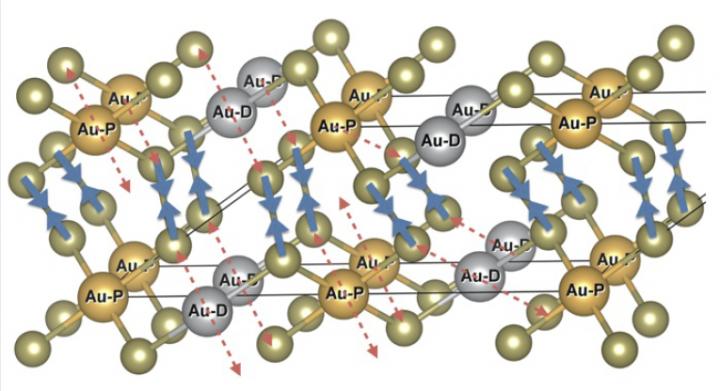
Scientists Uncover Calaverite’s Secrets: A Gold Tellurite Breakthrough

Formation of the Te-Te dimers due to charge disproportionation on Au sites.
Credit: S. V. Streltsov et al./PNAS
A gold tellurite with the chemical formula AuTe2, calaverite may not only be a source of gold, but displays highly incommensurate modulation in the positions of gold and tellurium atoms in its crystals.
This means that calaverite's crystal lattice cannot be explained by Haüy's law which describes the crystals of most minerals. Calaverite and other incommensurate crystals have long been a mystery for crystallographers.
In the 1970s, scientists found a way of describing their structures using 4D space instead of the customary 3D space in their calculations. However, researchers have been clueless as to the reasons of such weird behavior of calaverite crystals.
Research teams from the RAS Institute of Metal Physics (led by Professor Sergey Streltsov), the University of Cologne (led by Professor Daniil Khomsky), Skoltech and the Moscow Institute of Physics Technology (MIPT) (led by professor Artem Oganov) cracked the mystery of incommensurate calaverite crystals, gaining insights into their electronic spectra obtained in the experiments and their superconducting capability created by pressure or additives.
“The simple reasoning suggests that gold should be divalent in this compound in much the same way as iron is in FeS2, known as “fool's gold”. Any chemist understands that divalent gold is extremely unstable and tends to become monovalent and trivalent, but there lies the rub: first, 3+ is too high a valence and, second, there is no way you can place monovalent or trivalent gold (assuming it exists in the first place) on calaverite's triangular lattice with the pattern repeating in each direction.
Therefore, it's the nature that dictates the compromise by smoothly changing the valence of gold in the crystal. Tellurium's environment responds to the change and this results in bizarre crystal lattices,” explains Sergey Streltsov
The scientists also relied on the USPEX ? an advanced evolutionary algorithm created by Artem Oganov and intensively used by crystallographers worldwide ? to predict all the known stable tellurides of gold and a new telluride, AuTe, unknown until now.
“There's quite a story behind calaverite. Apart from its marked impact on the Gold Rush, the mineral has been a headache and a great paradox for crystallographers for decades. The deeper you dug into it, the more new questions came up.
Our team has succeeded in interlacing all the oddities of calaverite within a simple model, so experimenters can now hunt for the new compound we predicted, AuTe, which I'm sure is full of new riddles,” says Professor of Skoltech and MIPT Artem Oganov.












